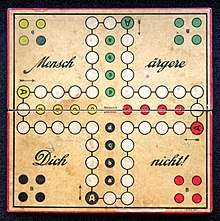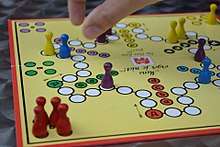Mensch ärgere Dich nicht
Mensch ärgere Dich nicht (English: Man, Don't Get Angry) is a German board game (but not a German-style board game), developed by Josef Friedrich Schmidt in 1907/1908. Some 70 million copies have been sold since its introduction in 1914. It is played in Germany, Croatia, Slovakia, the Czech Republic, Italy, the Netherlands,[1] and Iran.
 | |
| Designer(s) | Josef Friedrich Schmidt |
|---|---|
| Publisher(s) | Schmidt Spiele |
| Publication date | 1914 |
| Genre(s) | Board game |
| Language(s) | German |
| Players | 2 to 4 (2 to 6 on reverse side) |
| Setup time | 1 minute |
| Playing time | about 30 minutes |
| Random chance | High (die rolling) |
| Age range | 6+ |
| Skill(s) required | Counting, probability, strategy |

The name derives from the fact that a peg is sent back to the "out" field when another peg lands on it, similar to the later game Sorry!. It is a cross and circle game with the circle collapsed onto the cross, similar to the Indian game Pachisi, the Colombian game Parqués, the American games Parcheesi and Trouble, and the English game Ludo.
History
Roots
The game goes back to an old Indian game called Pachisi, which is still known today. Moreover, it is very common in Sri Lanka ('pahada kolya'), Malaysia ('dhola'), Myanmar ('pasit', 'chwe-pyit-thi' or 'ansah-pyit-thi'), Iran ('pachis'), as well as in Arabic countries ('parchis'). Finally, through the Moors, it was brought to Spain, and thus to Europe. Occasionally, it is played at oriental courts using household servants as tokens on correspondingly large fields.
Beginnings in the early 20th century
In its present form, Mensch ärgere Dich nicht was invented in the winter months of 1907/1908 by Josef Friedrich Schmidt, a native of Amberg, Germany and the founder of Schmidt Spiele. This game was invented in a workshop in Munich-Giesing and was based on the English game, Ludo. This game was first published in 1910 and was produced in series from 1914 on. Mensch ärgere Dich nicht is considered the most popular parlour game in Germany. In contrast to Ludo, the game's role model, Schmidt left aside all tactical and strategic variations in the rules. Also, the symbolism of the origin game, Pachisi, was completely eliminated.[2][3]
The rules of this classic game have essentially not changed since 1914, but now there are different variations of the game, e.g. Nichts als Ärger and Teufelsrad. While the game was not particularly successful in the early years, it became popular during the First World War. Schmidt sent 3,000 games to field hospitals so that the soldiers had something to do to escape boredom.[4] Thanks to this tactic and the subsequent word-of-mouth propaganda, it was possible to sell 1 million games at the price of 35 Pfennigs by 1920.
Developments and copies after the World War II
After the Second World War, the game remained largely unchanged in the Federal Republic of Germany. In 1953, Schmidt Spiele introduced an official Mensch ärgere Dich nicht version as a licensed edition in East Germany. Soon after, almost identical counterfeits appeared in Germany under the title of "Wir werfen raus!" and "Mensch wir werfen raus!". One version, "Verliere nicht den Kopf!" puts a shortcut across in the middle of the board. Its successor, "Raus!", which had a square-shaped board, was also being sold at the time.[5] Different counterfeits appeared in other countries, such as an Austrian version of the game, such as Das Spiel, by the Viennese publisher Werner Schneider Jr.[5] In addition to these games, many other promotional games appeared in the 1980s that were modeled after the original. Apart from these counterfeits, other internationally refined and independent games evolved from Mensch ärgere Dich nicht and other Pachisi spin-offs. These games include: Hexentanz, das VIP Game, Tock, its spin-off, Sorry!, Dog and DOG, as well as Huckepack. [5]
Further developments in the 21st century
Additionally, this board game established itself in tournament form.[6] On February 11, 2010, the Deutsche Post issued a 55 cent coin with a special stamp to celebrate the game's 100th anniversary.[7] In January 2014, Schmidt Spiele released a card game with the title Mensch ärgere Dich nicht: Das Kartenspiel.[8] Schmidt's hometown Amberg set the world record for simultaneous gameplay of Mensch ärgere Dich nicht with 1692 people on 375 game-boards in July 2017.[9]
Versions
Verliere nicht den Kopf
There is another version of the game called Verliere nicht den Kopf based on the same game mechanism as the original one. There are, however, two defining differences: whenever the player proceeds to any of the corner squares, they can take a diagonal shortcut for their next move to save half the trip. This way, every player can use two spots for shortcuts. However, to get to the finish line, all of the squares need to be reached by rolling the dice to get the exact number (first piece placed on the last square, second one on the second to the last etc). The original version allows the player to move the tokens within the finish area, if the roll is low enough. As a result, the piece remains in the game longer before it reaches the finish line, which increases the risk of being kicked out.
Rules
The most played variant of the game can be played by 2, 3, 4 players – one player per board side. The special one has a pattern for 6 players. Each player has four game pieces, which are in the "out" area when the game starts, and which must be brought into the player's "home" row.
The rows are arranged in a cross position. They are surrounded and connected with a circle of fields, over which the game pieces move in clockwise direction. There are three fields on each side of the board. At the beginning of the game, the players' pieces are placed in the four fields marked "B" on the far left side, the "out" section. The coloured field just left of centre, marked "A", is each player's "start" field. The white field just to the right of the start field leads to the "home" row, marked "a", "b", "c", "d". Each game piece enters the circle at the "start" field ("A"), moves (clockwise) over the board and finally enters the "home" row. The first player with all of their pieces in their "home" row wins the game.
The players throw a game dice in turn and can advance any of their pieces in the game by the thrown number of dots on the die.[10]
Throwing a six means bringing a piece into the game (by placing one from the "out" ("B") area onto the "start" or "A" field) and throwing the dice again. If a piece is on the "A" field and there are still pieces in the "out" area, it must be moved as soon as possible. If a piece cannot be brought into the game then any other piece in the game must be moved by the thrown number, if that is possible. A commonly played variation allows a player who has no pieces in the circle of fields to have three tries to throw a six.[10]
Pieces can jump over other pieces, and throw out pieces from other players (into that player's "out" area) if they land on them. A player cannot throw out his own pieces though, he can advance further than the last field in the "home" row. A player can be thrown out if he is on his "start" field.
References
- Uncle John's 24-Karat Gold Bathroom Reader. Portable Press. 2012. p. 387. ISBN 978-1-60710-655-5.
- "Am Anfang war nichts als Ärger..." Schmidtspiele.de. Retrieved 2011-01-27.
- Erwin Glonnegger (1988), Das Spiele-Buch. Brett- und Legespiele aus aller Welt. Herkunft, Regeln und Geschichte (in German), Ravensburger Buchverlag Otto Maier, p. 16, ISBN 3-9806792-0-9
- Dorothea Heß. "Mensch ärgere Dich nicht!". spielbox.de. W. Nostheide Verlag. Retrieved 2011-01-27.
- Andreas Mutschke: "Wie man ein Spiel klont am Beispiel Mensch ärgere dich nicht!" spielbox 3/1991, June/July; pp. 38–40.
- "Mensch-ärgere-Dich-nicht-Turniere". Das Turnier. Retrieved 2018-09-01.
- "Jetzt zum Aufkleben: Mensch ärgere Dich nicht". spielbox.de. W. Nostheide Verlag. 2010-02-02. Archived from the original on 2014-02-01. Retrieved 2011-01-27.
- "Mensch ärgere Dich nicht – Das Kartenspiel", schmidtspiele.de
- "Weltrekord im M.ä.D.n.-Spielen 2017 in Amberg"
- Spielanleitung (rules of the game), schmidtspiele.de (in German)
External links

- "Mensch ärgere Dich nicht: Geschichte eines Spieleklassikers" ("Story of a Classic Game"), Nuremberg Toy Museum (in German)